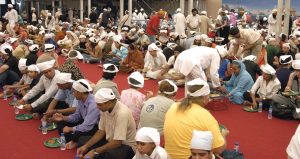What is a Langar ?
What is a Langar ?
Langar or community meal is one of the fascination features of Sikh religion. Though langars are prepared everyday in Gurudwaras, they are specially looked forward to on special occasions such as Gurupurabs.
A special Langar is also prepared on the occasion of Baisakhi – a festival that marks the foundation day of Khalsa Panth, and everyone participates in it with great enthusiasm and gusto.
In Sikhism, Guru ka Langar stands for community kitchen in or adjacent to a Gurdwara that is run in the name of Guru. Langar can also mean a free, vegetarian-only meal served in a gurudwara.
The practice of langar was started by Guru Nanak Dev Ji to break the caste system that was prevalent in India during the 13th and 14th centuries.

Hence, both the kitchen and meal is open to all twice a day, throughout the year without any discrimination on the basis of religion, caste, colour, creed, age, gender or social status.
Hence, in a langar, all people high or low, rich or poor, male or female, all sit in the same pangat (meaning row or line) to share and enjoy the food together.
In an attempt to invite all and offend no one, the food in langar is always vegetarian. It usually consists of lentil soup, vegetables, rice and chappatis.
This practice of Langar is one of the Three Pillars of Sikhism and symbolizes the desire of Sikhs to eradicate hunger.
The Sikhs are encouraged to donate ten percent (daswandh) of their wealth, time, or resources to a worthy cause, of which Langar Sewa is one.
The practice of Langar Sewa is widely followed by Sikhs even in present times. A large number of Sikh families volunteer each week to provide and prepare the Langar.
It may be noted that preparing langar is quite a task as there may be several hundred people to feed, and caterers are not allowed.
Voluntary helpers (Sewadars) do all the preparation, the cooking and the washing-up.
Rules for Making a Langar
- According to Sikhism, following protocol should be strictly observed while making of the langar:
- Guru’s Langar must always be vegetarian and should be made up of simple, nourishing food.
- Strict rules of purity, hygiene and cleanliness must be observed while making of the langar.
- When preparing food for the Langar, the mouth and nose should be covered by a piece of cloth known as a “parna”.
- The sevadars (selfless workers) should wash hands before beginning to cook langar and never taste it while cooking.
- The sewadars will normally utter Gurbani and refrain from speaking if possible.
- Individuals with communicable diseases should not participate in the preparation of Langar.
- When the Langar is ready, a small portion of each of the dishes is placed in a plate or bowls and placed in front of the Sri Guru Granth Sahib and a prayer called the Ardas is performed. The Ardas is a petition to God, a prayer to thank the Creators for all His gifts and blessings.
- A steel kirpan is passed through each item of food, after the “Guru-Prashad” has been blessed. The blessing of the Langar with Ardas can be done anywhere, in case the Langar needs to be served before the completion of the Gurdwara ceremony.
- The Langar is not eaten until the Ardas has been recited.
- After the Ardas is completed, each item of food is returned back to its original pot or container. This is done in a belief that the blessings of the “holy” food are thus passed to the entire Sangat through the Langar.
How is Langar Served ?
In Sikh religion, there is a following prescribed code of conduct for serving the langar:
- When serving the Langar, the servers must observe strict rules of cleanliness and hygiene.
- Servers should not touch the serving utensils to the plates of those they serve.
- When serving foods by hand, such as chapatis or fruit, the server’s hands should not touch the hand or plate of those they are serving.
- Those serving should wait until all others have been completely served before they sit down to eat themselves.
- When distributing food in the langar, sewadar should not be a greedy person. He should not keep a large portion for himself, and should serve Pangat without any prejudice or discrimination. Besides, he should not serve unequal portions.
- Sewadar should not distribute food without concern for the approved procedure.
- Person serving the food should not consume anything that is proscribed.
- Sewadar should never eat without first reciting fapuji.
- Sewadar should say `Praise to the Guru’ before eating.
- Sewadar should not distribute nor eat food bareheaded.
Etiquettes to be observed while having Langar
Following etiquettes and guidelines must be observed while having a langar:
- Since many people do not believe in the consumption of meat and eggs, foods of this sort should not be brought into the Gurdwara.
- Alcoholic/narcotic substances are strictly against the Sikh diet, hence these are strictly not allowed on Gurdwara premises.
- Head should be covered with a piece of cloth while having langar.
- It is advisable not to leave any leftovers.
Significance of Langar in Sikhism
The institution of Guru ka Langar has served Sikhism in many ways.
It has ensured the participation of women and children in a task of service for mankind as women play an important role in the preparation of meals, and the children help in serving food to the pangat.
Langar also teaches the etiquette of sitting and eating in a community situation, which helps harbor, the feeling of oneness in the society.
In present time, the institution of langar has become an integral part of the Sikh movement. Langars have been established in several countries around the world wherever there are Sikhs and, people of all communities participate in it with enthusiasm.